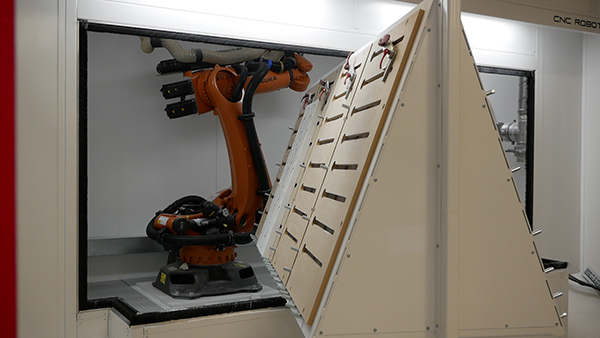A company manufacturing industrial furnaces and ovens has switched from a flat-bed router to a robotic cell designed and developed by CNC Robotics Ltd. The cell uses a Kuka robot arm programmed with Alphacam CADCAM software and RoboDK to cut insulation material at speeds of up to eight times faster than before.

Carbolite Gero, based in Hope, Derbyshire, uses a variety of insulation materials like Kerform insulation board, refractory brick and ceramic materials to keep the temperature of its steel outer cases down to around 60°C, while the internal temperature peaks at 1200°C. The ovens and furnaces are used in a range of testing and heat-treatment processing facilities across sectors such as aerospace, general engineering, materials science, medical, bioscience, contract testing laboratories and universities, to see how products and liquids react in a heated environment.
The company was already using Alphacam to drive its three-axis Biesse router, but plant manager Nigel Holmes-Taylor says the Kerform board, along with other insulation materials, produces a highly abrasive dust when cut, which causes considerable wear on exposed parts of the CNC machine.
“We came across robotic arms with a routing attachment, and decided that was the path to take,” he says.
The company approached CNC Robotics, a UK-based robotics integration company that specialises in machining with robots. An important issue for Carbolite, though, was that it wanted to keep its Alphacam programs and integrate them into the robotic cell. No problem, said Nick Parry, systems engineer and technical lead with CNC Robotics, who led the development of the single enclosed robotic cell.

CNC Robotics founder and owner Jason Barker explains further: “When machining, we need to simulate the robot correctly to give raw data of where the robot goes, to check for potential crashes. Simulation is also vital for checking correct posture, singularity, wrist and elbow, and axis limits. The importance of ‘what you see is what you get’ is critical. If it crashes on screen it will crash in the real world. Using software such as Alphacam and RoboDK means you can correct all that before we go anywhere near the robot itself.
“And being able to convert the existing Alphacam programs that powered the router meant there was no downtime learning a new software,” he adds. “Carbolite was able to take their existing programs and redevelop them into the robotics world.”
Martin Measures, Alphacam area sales manager, explains how the simulation issue was overcome: “Tool paths created in Alphacam are passed directly to a RoboDK interface within the software, which simulates the robot kinematics. RoboDK is a specially configured software development kit (SDK) which outputs the co-ordinate cutting data to drive the robot. It means we can see exactly what the robot’s going to do before it processes the parts.”
And Holmes-Taylor says that because Carbolite’s new robotic cell can move at up to 2 m/sec, it provides a significant improvement over the company’s previous manufacturing process.
“Cutting speeds are far quicker on the robot than on the flat bed router,” he states. “While the router was restricted to working in three axes, the robot arm effectively has six axes, but can actually be infinite in the way it operates.”
His team takes the part files from drawings produced by the engineering facility, and imports them into Alphacam.
“This brings all the cutting paths together, and sends the program to the post processor, which is then fed into the RoboDK module for simulating the movement of the robotic arm,” says Holmes-Taylor.

As the Kerform board comes in a variety of thicknesses and temperature grades, the robotic cell designed by CNC Robotics provides an additional benefit versus a flat-bed machine.
“Thanks to a special rotating table, we’ve now got four positions on both sides of the bed, which means we can cut several different types of board needed to produce a full unit, at the same time,” says Holmes-Taylor. “With the flat-bed router we could only deal with one type of board at a time, so this gives us a 4:1 ratio of cutting it quicker. In some circumstances it’s up to eight times faster.
“The rotating table that works this has a set angle at which the cutter hits the board, and Alphacam, in conjunction with RoboDK, ensures the robot keeps to that exact angle at all times, cutting in a straight line and at the correct depth,” he adds.
As the board has a high aluminium content, another improvement is that all the abrasive dust created during the cutting process is contained within the cell and drawn out through Carbolite’s extraction system, meaning the overall environment is much cleaner.
Finally, an added bonus, as Alphacam can produce a full description of what needs to be added to each specific site at the loading bay, CNC Robotics has been able to develop a piece of software that displays the PDF generated by Alphacam.
“This means that the operative loading the machine knows the next material to load, and where it has to go, saving even more time,”
says Holmes-Taylor.
The partnership between CNC Robotics, Alphacam, RoboDK and Kuka is an optimal solution for Carbolite, according to Kuka’s UK sales channel manager Tara Baker: “Kuka works with a system partner network. System partners like CNC Robotics provide even more industry-specific know-how. CNC Robotics designed and integrated everything into the enclosed cell, turning the robot into a highly effective CNC machine. Furthermore, Alphacam/RoboDK provides a back-up service for the software. It’s a one-stop solution for Carbolite, helping them to future-proof their business.”
For further information www.alphacam.com














